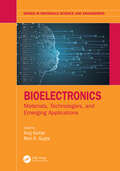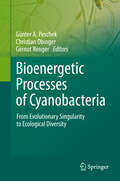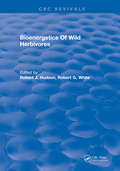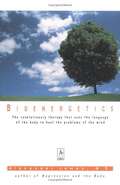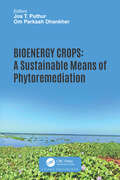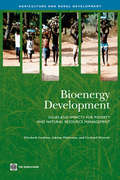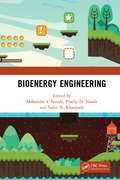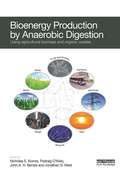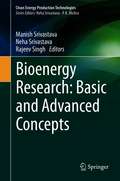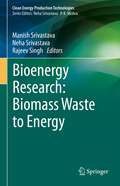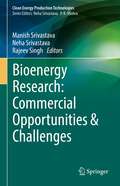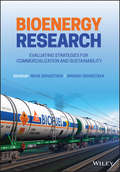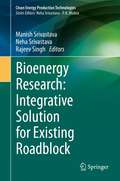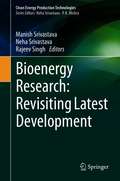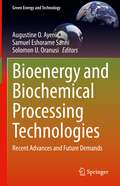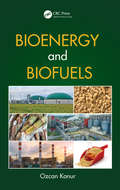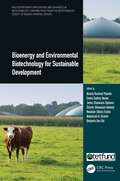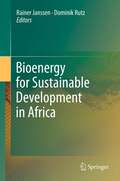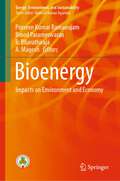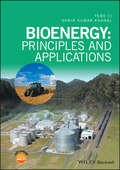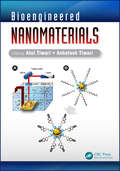- Table View
- List View
Bioelectronics: Materials, Technologies, and Emerging Applications (Series in Materials Science and Engineering)
by Anuj Kumar Ram K. GuptaBioelectronics is emerging as a new area of research where electronics can selectively detect, record, and monitor physiological signals. This is a rapidly expanding area of medical research, that relies heavily on multidisciplinary technology development and cutting-edge research in chemical, biological, engineering, and physical science. This book provides extensive information on the (i) fundamental concepts of bioelectronics, (ii) materials for the developments of bioelectronics such as implantable electronics, self-powered devices, bioelectronic sensors, flexible bioelectronics, etc, and (iii) an overview of the trends and gathering of the latest bioelectronic progress. This book will broaden our knowledge about newer technologies and processes used in bioelectronics.
Bioelectrosynthesis (Advances in Biochemical Engineering/Biotechnology #167)
by Falk Harnisch Dirk HoltmannThis volume discusses both the latest experimental research in bioelectrosynthesis and current applications. Beginning with an introduction into the “electrification of biotechnology” as well as the underlying fundamentals, the volume then discusses a wide range of topics based on the interfacing of biotechnological and electrochemical reaction steps. It includes contributions on the different aspects of bioelectrochemical applications for synthesis purposes, i.e. the production of fine and platform chemicals based on enzymatically or microbially catalyzed reactions driven by electric energy. The volume finishes with a summary and outlook chapter which gives an overview of the current status of the field and future perspectives. Edited by experts in the field, and authored by a wide range of international researchers, this volume assesses how research from today’s lab bench can be developed into industrial applications, and is of interest to researchers in academia and industry.
Bioenergetic Processes of Cyanobacteria: From Evolutionary Singularity to Ecological Diversity
by Christian Obinger Gernot Renger Guenter A. PeschekThis publication is unique among a number of books on cyanobacteria because it focuses on the bioenergetics of these widespread organisms which are the evolutionary prerequisite for the development of all higher forms of life on our "blue" planet. The book primarily addresses questions of energy conversion by the fundamental bioenergetic processes: (oxygenic) photosynthesis, (aerobic) respiration, and (anaerobic) fermentation which uniquely occur together in these prokaryotic cells. Thermophilic cyanobacteria offer the most suitable material for high resolution structure analyses of Photosystem I and II and other electron transport complexes by X-ray crystallography (for example, at present the structure of Photosystem II at atomic resolution is only known for these organisms). These achievements during the last decade represent a milestone in our understanding of the complexes which are crucial for solar energy exploitation through photosynthetic water splitting. The present work represents an ambitious attempt to achieve the goal of a synoptic state-of-the-art picture by casting together the mosaics of detailed knowledge described by leading experts in the field. It contains 24 chapters written by 35 authors from Europe, USA, India and Japan. The book is aimed at reaching a broad audience ranging from students to experienced scientists. The editors wish all readers a pleasant and stimulating journey through the fascinating "world" of the bioenergetics of cyanobacteria and sincerely hope that this book will not only be of great value for the experts but also entice young people into this exciting research area with the aim to address successfully the challenging problems of high relevance that are still waiting for a satisfactory answer.
Bioenergetics Of Wild Herbivores
by Robert J. HudsonBioenergetics is an emerging discipline which offers a more profound understanding of the ecology, behaviour, and evolution of wild herbivores. Increasingly, bioenergetic principles have been applied in management since they provide insight into population dynamics and are relevant to manipulation of habitats and assessment of the impacts of resource development. Growing interest in the agricultural potential of wild herbivores has provided further impetus. In spite of this promise, there are few comprehensive syntheses of the concept and its application to wild herbivores. This volume attempts to fill this need. This book provides a great amount of detail but its expressive aim is to lead us to the whole animal, to a herd, to population as integral parts of an ecological entity which in turn is the result of evolutionary forces.The concept of this book promises the realization of an overdue change in the approach to bioenergetics, to nutrition and husbandry, and thus to the management of wild herbivores: the final emancipation from rules and views based primarily on domesticated herbivores or on experimental animals held under unnatural conditions, necessarily impending them behaviourally, physically, and psychically.
Bioenergetics: A Bridge across Life and Universe
by Davor JureticBioenergetics deals with the very first energy transformation steps performed by living cells. Increased dissipation is the primary effect of processing external energy packages. Enzyme-supported charge separation is the minor but essential outcome for maintaining life. This book explores the usefulness of dissecting the entropy production of enzymes involved in cellular defenses, fermentation, respiration, and photosynthesis, assuming that tightly regulated dissipation is the hallmark of life. Researchers, educators, and students of life sciences can find in this text many examples of how we can use the interdisciplinary approach to study cells' virtuoso ability to connect the microscopic to the macroscopic world. Each chapter is a self-contained unit with a glossary and selected references for further reading.
Bioenergetics: The Revolutionary Therapy That Uses The Language Of The Body To Heal The Problems Of The Mind (Compass Ser.)
by Alexander LowenBioenergetics is the revolutionary new therapy that uses the language of the body to heal the problems of the mind. This exciting body-mind approach to personality has a liberating and positive effect on emotional, physical, and psychic distress. Dr. Alexander Lowen, founder and prime mover of this fast-growing therapy, writes that increased joy and pleasure are possible in every day life through an understanding of how your body functions energetically: how it determines what you feel, think, and do. Dr. Lowen points out that lack of energy is the result of chronic muscular tensions, a condition caused by the suppression of feelings. <P><P>These tensions can be dissolved through the direct body work in bioenergetic exercise, which restores the potential for living a rich, full life. Dr. Lowen analyzes common physical ailments like headaches and lower back pain and shows how they too can be overcome by releasing the muscular tenstion that create them. Generously illustrated with line drawings of bioenergetic exercises, this book is sure to bring freedom, confidence, and pleasure to thousands of men and women. <P><P>"In this highly interesting and valuable attempt to restore the body to the mind, Dr. Alexander Lowen sets out in a practically useful way the principles of his new form of psychotherapy. Bioenergetics is destined to become widely influential."
Bioenergy Crops: A Sustainable Means of Phytoremediation
by Jos T. PuthurBioenergy Crops: A Sustainable Means of Phytoremediation comprises a unique combination of topics related to the field of phytoremediation and bioenergy production. It highlights the future face of industries in phytoremediation and bioenergy production. The book deals with most promising plant and alga species for biomass production and phytoremediation. It deals with constructed wetlands, bioremediation and microbial fuel cells with case studies of phytoremediation and bioenergy production. The comprehensive knowledge on the dual aspects of hyperaccumulators in phytoremediation and bioenergy production guides graduates, post-graduates as well as researchers to know the latest updates in the field. Key Features:• Presents dual aspects of hyperaccumulators in phytoremediation and bioenergy production.• Highlights the future face of industries in phytoremediation and bioenergy production.• Focuses the promising candidates exploits as hyperaccumulator and biomass producers.• Explains the role of algae and microbes in bioremediation and bioenergy production.• Represents a comprehensive, up-to-date analysis in the field of phytoremediation as well as bioenergy production.
Bioenergy Development: Issues and Impacts for Poverty and Natural Resource Management
by Gerhard Dieterle Elizabeth Cushion Adrian WhitemanBioenergy has been critically important since our ancestors first used wood to cook their food and stay warm at night. Traditional forms of bioenergy, firewood and cow dung patties, remain primary fuel sources for many rural and poor people. More modern sources of bioenergy--including ethanol and biodiesel for transport and wood pellets for heating, among many others--offer great promise but generate great controversy. This book gives an overview of bioenergy developments. It examines the main issues and possible socioeconomic implications of these developments, as well as their potential impacts on land use and the environment, especially with respect to forests. The authors present an introduction to bioenergy, provide a background and overview of solid biomass and liquid biofuels, and examine the opportunities and challenges at the regional and country levels. They also examine potential impacts for specific types of bioenergy. 'Bioenergy Development' does not attempt to be definitive on such subjects as the impact of bioenergy on food prices, but it does suggest the tradeoffs that need to be examined when considering bioenergy policies. The authors offer five main findings: Solid biomass will continue to provide a principal source of energy and should not be overlooked. There will be major land-use implications resulting from bioenergy developments. It is critical to consider tradeoffs-including those related to poverty, equity, and the environment-when considering bioenergy policies. There is considerable potential for an increased use of forestry and timber waste as a bioenergy feedstock. The climate change impacts of bioenergy development are uncertain, and highly specific to location and feedstock.
Bioenergy Engineering
by Mahendra S. Seveda; Pradip D. Narale; Sudhir N. KharpudeThe book provides information on recent advancements in bioenergy engineering to graduates, post-graduates, research scholars, faculty members, academician, researchers and practitioners studying and working in field of the bioenergy engineering. It is an invaluable information resource on biomass-based biofuels for fundamental and applied research, catering to researchers in the areas of biogas technology, densification techniques, biomass gasification, torrefaction of biomass, biochar production, micro algae production, improved biomass cookstoves, bio-ethanol production and the use of microbial processes in the conversion of biomass into biofuels. It will also be useful to faculties and researchers to understand the present status, advancements and policies in implementation of bioenergy technologies in India. This book will definitely provide a direction to the young researchers in identification of thrust areas of research in the field of bioenergy. The book concludes with research and development endeavours and aspects relating to implementation of advance bioenergy technologies.
Bioenergy Production by Anaerobic Digestion: Using Agricultural Biomass and Organic Wastes (Routledge Studies in Bioenergy)
by Nicholas E. Korres Padraig O'Kiely John A.H. Benzie Jonathan S. WestInterest in anaerobic digestion (AD), the process of energy production through the production of biogas, has increased rapidly in recent years. Agricultural and other organic waste are important substrates that can be treated by AD. This book is one of the first to provide a broad introduction to anaerobic digestion and its potential to turn agricultural crops or crop residues, animal and other organic waste, into biomethane. The substrates used can include any non-woody materials, including grass and maize silage, seaweeds, municipal and industrial wastes. These are all systematically reviewed in terms of their suitability from a biological, technical and economic perspective. In the past the technical competence and high capital investment required for industrial-scale anaerobic digesters has limited their uptake, but the authors show that recent advances have made smaller-scale systems more viable through a greater understanding of optimising bacterial metabolism and productivity. Broader issues such as life cycle assessment and energy policies to promote AD are also discussed.
Bioenergy Research: Basic and Advanced Concepts (Clean Energy Production Technologies)
by Neha Srivastava Manish Srivastava Rajeev SinghThis volume is first part of the five-part set on bioenergy research. This volume covers current developments and both basic and advanced concepts in bioenergy production. Based on bioenergy road map, the book will also evaluate about the ratio existing between current challenges associated and practical implementation of these biofuels. The book complies up to-date progressive development in available bioenergy options and discusses opportunities and existing risks. The main objective of the book is to provide insights into the opportunities and required actions for the development of an economically viable bioenergy industry for practical replacement of fossil fuels. This book is of interest to teachers, researchers, scientists, capacity builders and policymakers. Also the book serves as additional reading material for undergraduate and graduate students of environmental sciences. National and international bioenergy scientists, policy makers will also find this to be a useful read. Other four volumes of this set explore latest developments, commercial opportunities, waste to energy and integrated solution for bioenergy concerns.
Bioenergy Research: Biomass Waste to Energy (Clean Energy Production Technologies)
by Neha Srivastava Manish Srivastava Rajeev SinghThis volume is fourth part of the five-part set on bioenergy research. This volume covers biomass to bioenergy production concept. The book is focused on the possible and versatile biomass options available for the generation of bioenergy. Additionally, the book also explores different types of biomass for bioenergy generation at a commercial level. Further, the book elaborates on different kind of cellulose and sugar rich waste which can also be utilized for bioenergy production. It covers other relevant issues such as recent technological advancement in biomass to bioenergy conversion, waste management in the context of biomass to biofuels production technologies, green methods of energy production, alternates of fossil fuels in the near future. It also explores biomass waste valorization, utilizing microbial processes in bioenergy production. This is a useful reading material for students, researchers, industry and policy experts.Other four volumes of this set explore basic concepts, latest progress, commercial opportunities and integrated solution for bioenergy concerns.
Bioenergy Research: Commercial Opportunities & Challenges (Clean Energy Production Technologies)
by Neha Srivastava Manish Srivastava Rajeev SinghThis volume is third part of the five-part set on bioenergy research. This book provides insights into commercial advantages of commonly running bioenergy options. It explores various opportunities present at technical scale to produce biofuels. Moreover, the additional practical feasibility of the commercialization of existing biofuels including existing challenges and sustainable solutions to overcome from these technical hurdles. This Volume also focuses on the durability and long run sustainability on the new arrival of biofuels options which can be a suitable and easy replacement of currently available biofuels at pilot scale. Other four volumes of this set explore basic concepts, latest progress, bio-waste to energy conversion and integrated solution for bioenergy concerns.
Bioenergy Research: Evaluating Strategies for Commercialization and Sustainability (Clean Energy Production Technologies Ser.)
by Neha SrivastavaBIOENERGY RESEARCH Evaluates challenges and sustainable solutions associated with various biofuel technologiesBioenergy Research offers an authoritative guide to recent developments in green bioenergy technologies that are currently available including: bioethanol, biobutanol, biomethanol, bio-oil, biohydrogen, biogas and biomethane. The authors provide in-depth analysis and discuss the commercial viability of the various technological advances in bioenergy. Comprehensive in scope, the book explores the environmental, practical and economic implications associated with a variety of bioenergy options. The book also considers the rollback of fossil fuels, the cost and their replacement as well as practical solutions for these issues.This important resource:Presents up-to-date research and industrial developments for various bioenergy optionsOffers comparative evaluation of bioenergy technologies for commercial feasibilityReviews current challenges and sustainable solutions for a variety of biofuel technologiesContains a review of existing strategies for bioenergy productionBioenergy Research is a valuable guide for academic researchers and industrial scientists working in the fields of biofuels and bioenergy, environmental science and technology, microbial technology, bioprocess engineering, and waste valorization.
Bioenergy Research: Integrative Solution for Existing Roadblock
by Neha Srivastava Manish Srivastava Rajeev SinghThis volume is fifth part of the five-part set on bioenergy research. This edited volume provides sustainable solution for all existing roadblocks in commercial bioenergy production. The book focuses on different types of obstacles involved in various bioenergy operations with detail remedy of the issue in a sustainable way. In spite of having number of potential advantages, all available bioenergy options are still far from smooth practical applicability, due to which they are still in pipeline phase to replace the fossil fuels. This book brings together the integrative approach to the readers, to connect with more viable bioenergy type on commercial scale, the existing issues and the feasible approaches to eliminate the bottlenecks in the process. Further, the book also uncovers the untouched area of bioenergy production technology by bringing forth unconventional methods, processes and parameters, which have scope to enhance biofuel production technology by “Lab to Land” methods. The book highlights aspect which are less studied or are very new in their industrial application of bioenergy production. The book presents relevant reading material for global researchers, academic institutions, research students, teachers, scientist as well as industries. Other four volumes of this set explore basic concepts, latest progress, commercial opportunities and bio-waste to energy conversion.
Bioenergy Research: Revisiting Latest Development (Clean Energy Production Technologies)
by Neha Srivastava Manish Srivastava Rajeev SinghThis volume is second part of the five-part set on bioenergy research. This book provides new insight about the latest development in bioenergy research. It presents the various bioenergy options which are further explored for practical viability, their progress and utility in the industry. The main objective of the book is to provide insights into the opportunities and required actions for the development of an economically viable bioenergy industry for practical replacement of fossil fuels. This book is of interest to teachers, researchers, scientists, capacity builders and policymakers. Also the book serves as additional reading material for undergraduate and graduate students of environmental sciences. National and international bioenergy scientists, policy makers will also find this to be a useful read. Other four volumes of this set explore basic concepts, commercial opportunities, waste to energy and integrated solution for bioenergy concerns.
Bioenergy and Biochemical Processing Technologies: Recent Advances and Future Demands (Green Energy and Technology)
by Augustine O. Ayeni Samuel Eshorame Sanni Solomon U. OranusiThis book presents novel techniques, current trends, and cutting-edge technologies in energy and biochemical processes. The authors explore recent advances that solve challenges related to the implications and commercialization of these processes by introducing new techniques or modifying existing technologies to meet future demands for food materials, bioproducts, fossil fuels, biofuels, and bioenergy. Divided into three parts, the first section of the book addresses issues related to the utilization and management of energy towards the efficient characterization and conversion of wastes or raw-/bio- materials to useful products. The second section focuses largely on studies on molecular detection of analytes, purification, and characterization of products recovered from biochemical, enzymatic, food, and phytochemicals, as well as biostimulation and bioaugmentation processes. The final section discusses areas related to heat and mass transfer, fuel processing technologies, nanofluids, and their applications.
Bioenergy and Biofuels
by Ozcan KonurThis book aims to inform readers about the recent developments in bioenergy and biofuels covering current issues from an interdisciplinary approach. It will also feature coverage of anticipated future trends related to each particular biofuel. Chapters will consist of original research presented by world class experts in their respective fields. A number of interdisciplinary areas will be incorporated such as Energy & Fuels, Biotechology, Genomics, Economics, Optimization, Chemical Engineering, Mechanical Engineering and Algae Science. Examples will relate to a matrix of biofuel and energy types such as bioethanol, biobutanol, and biomethane.
Bioenergy and Environmental Biotechnology for Sustainable Development (Multidisciplinary Applications and Advances in Biotechnology)
by Akinola Rasheed PopoolaThis book covers a range of important topics on environmental remediation, biofuels and value-added microbial products for environmental clean-up, water and wastewater recycling and sustainable wastewater treatment using microalgae. Designed to document advances in biotechnology, this book highlights bio-resource utilization in fostering low-carbon renewable energy-based economies and provides new insights into chlorine disinfectant usage in water treatment, wastewater treatment using microalgae, etc. The book will be useful reference material for scientists and researchers in the fields of microbial biotechnology and bioremediation, environmental biotechnology and sustainable development, climate change mitigation, provision of safe water and sustainable wastewater recycling. Emphasizes recent advances in bioremediation techniques towards environmental sustainability Provides detailed information on how to harness indigenous bio-resources including microorganisms as bioenhancement agents for environmental remediation Introduces new frontiers in the area of wastewater treatment using microalgae — important for sustainability and water safety Reviews biotechniques that could enhance higher levels of sustainability in heavily polluted environments and also provides an intelligent monitoring system for waste recycling and environmental remediation, and fostering a low-carbon renewable energy–based bioeconomy Discusses the need for review of existing guidelines on chlorine disinfectant usage for enhanced water quality Akinola Rasheed Popoola, Ph.D., is a Professor of Plant Pathology and the Director of the Biotechnology Centre, Federal University of Agriculture, Abeokuta, Nigeria. Emeka Godfrey Nwoba, Ph.D., is a research scholar at the Algae Research & Development Centre, Murdoch University, Western Australia. James Chukwuma Ogbonna, Ph.D., is a Professor of Microbiology and Biotechnology and Director, National Biotechnology Development Agency, South East Zonal Biotechnology Centre, University of Nigeria, Nsukka, Nigeria. Charles Oluwaseun Adetunji, Ph.D., is an Associate Professor of Microbiology and Biotechnology, and Director of Intellectual Property and Technology Transfer, Edo State University, Uzairue, Nigeria. Nwadiuto (Diuto) Esiobu, Ph.D., is a Professor of Microbiology and Biotechnology at Florida Atlantic University, Boca Raton, FL, USA, and the President and Founder of Applied Biotech Inc. and ABINL, Abuja, Nigeria. Abdulrazak B. Ibrahim, Ph.D., is a Capacity Development Expert at the Forum for Agricultural Research in Africa (FARA) and an Associate Professor of Biochemistry, Ahmadu Bello University, Zaria, Nigeria. Benjamin Ewa Ubi, Ph.D., is a Professor of Plant Breeding and Biotechnology and Director, Biotechnology Research and Development Centre, Ebonyi State University, Abakaliki, Nigeria.
Bioenergy for Sustainability and Security
by Ajit Varma Basanta Kumara BeheraThis book discusses the generation of green energy, providing fundamental scientific information on the availability of sustainable biological resources. It addresses inter- and multidisciplinary topics, including policies and strategies for sustainable energy; the environment and advanced renewable energy technology; electricity generation through solid waste management; and direct electricity generation using microbial fuel cells. It examines the application of the principles and quantitative relationships that define the process – as an effective technique to teach applied aspects of biomass energy technology conversion. In addition, it describes the latest commercialisation of microbial fuel cell technologies, bio-diesel production from microalgae, fermentation technology based on biobutanol from bacteria, and direct ethanol production from microalgae with attractive illustrations and models developed by corporate sectors.
Bioenergy for Sustainable Development in Africa
by Dominik Rutz Rainer JanssenThe work builds on the results of the COMPETE Bioenergy Competence Platform for Africa, which was supported by the European Commission and coordinated by WIP Renewable Energies, Germany. The five sections cover biomass production and use, biomass technologies and markets in Africa, biomass policies, sustainability, and financial and socio-economic issues. This valuable work is, in effect, a single-source treatment of a key energy sector in a part of the world which still has a lot of unrealised potential for development.
Bioenergy from Dendromass for the Sustainable Development of Rural Areas
by Albrecht Bemmann Michael Bredemeier Christian Ammer Norbert Lamersdorf David Butler ManningBased on the results of two bioenergy research initiatives in Germany, this reference examines the sustainable management of wood biomass in rural areas. The large number of participating organizations and research institutes ensures a balanced and unbiased view on the potentials and risks is presented, taking into account economic, ecological, and social aspects. Most of the results reported are available here for the first time in English and have been collated in central Europe, but are equally applicable to other temperate regions. They highlight best practices for enhancing dendromass potential and productivity, while discussing the implications on rural economies and ecosystems.
Bioenergy: Impacts on Environment and Economy (Energy, Environment, and Sustainability)
by Binod Parameswaran B. Bharathiraja Praveen Kumar Ramanujam A. MageshThis contributed volume discusses the impact of bioenergy on the environment and economy. The book contents include contributions on themes, such as the impact of emulsified biofuels on the environment, environmental impacts of the current uses of biomass energy, sustainable development in ecosystem, trends in microbial fuel cells and the ecological and economic impacts on biofuel production, among others. The book also uses visual elements to aid learning. This book is a valuable, hands-on resource for researchers, academics and industry professionals, who are interested in alternative fuels, sustainability, clean energy, biofuel production, waste management, environmental pollution, renewable energy and allied fields.
Bioenergy: Principles and Applications
by Yebo Li Samir Kumar KhanalThe search for altenative, renewable sources of fuel and energy from plants, algae, and waste materials has catalyzed in recent years. With the growing interest in bioenergy development and production there has been increasing demand for a broad ranging introductory text in the field. Bioenergy: Principles and Practices provides an invaluable introduction to the fundamentals of bioenergy feedstocks, processing, and industry. Bioenergy provides readers with an understanding of foundational information on 1st, 2nd, and 3rd generation biofuels. Coverage spans from feedstock production of key energy sources such as grasses, canes, and woody plants through chemical conversion processes and industrial application. Each chapter provides a thorough description of fundamental concepts, definitions of key terms, case studies and practical examples and exercises. Bioenergy: Principles and Practices will be an essential resource for students, bioengineers, chemists, and industry personnell tying key concepts of bioenergy science to valuable real world application.
Bioengineered Nanomaterials
by Atul Tlwarl Ashutosh TlwarlMany varieties of new, complex diseases are constantly being discovered, which leaves scientists with little choice but to embrace innovative methods for controlling the invasion of life-threatening problems. The use of nanotechnology has given scientists an opportunity to create nanomaterials that could help medical professionals in diagnosing and
